Apple's iPhone 4: Thoroughly Reviewed
by Brian Klug & Anand Lal Shimpi on June 30, 2010 4:06 AM EST- Posted in
- Smartphones
- Apple
- iPhone 4
- Gadgets
- Mobile
I'm not sure how this keeps happening. The first year I waited at a mall for 5 hours to get the original iPhone. The following year my friend Mark Rein convinced me to see a midnight showing of Hellboy II and then wait outside of an AT&T store all night to get the iPhone 3G. You'd think I'd learn by the third year but once more I was in line at the mall hours before the Apple store opened to get the 3GS. This year I thought it would be different. Apple offered free overnight shipping to anyone who wanted to pre-order the iPhone 4. Figuring everyone would go that route I decided to beat the FedEx trucks and just show up at the mall at 6AM. I'd be in and out in a little over an hour, which would give me a head start on battery life testing on Apple's 4th generation iPhone.
I promise that not all of my decisions play out this poorly. Those who pre-ordered the 4 and requested overnight delivery got their phones early and my one hour wait turned into six hours at the mall, for the fourth year in a row.
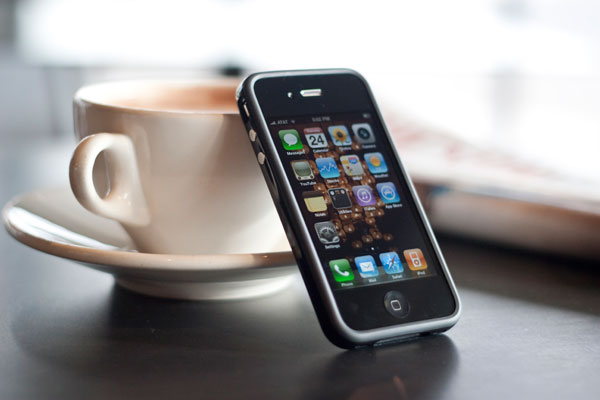
Apple's iPhone 4 with Bumper Case
It's a self fulfilling prophecy. Steve gets up on stage, proclaims the iPhone 4 to be the biggest introduction since the original iPhone, and the public flocks to Apple stores to fork over $200 on day one and around $2500 over the course of two years for the privilege. But this isn't 2007. Apple has real competitors in the smartphone space. Android phones have grown in features, polish and popularity. Even Palm entered the race with a competant offering, and Microsoft isn't far behind. It's easy to start a revolution when everyone else is doing the wrong thing, but what about when more companies actually get it? Was Steve justified in his excitement over the 4? That's what we're here to find out today.
Straight on it looks like just another iPhone. You get the black face with a shiny trim. From the side it is the redesign that Apple has needed for a while now. It’s not revolutionary but it’s the type of improvement that makes its predecessor feel old. And that’s exactly what this does. Have a look for yourself:
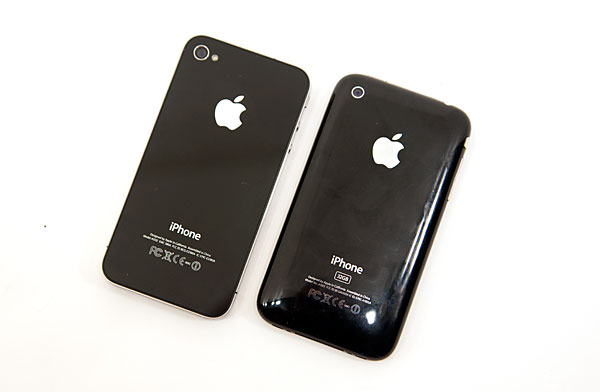
iPhone 4 (left) vs. iPhone 3GS (right)
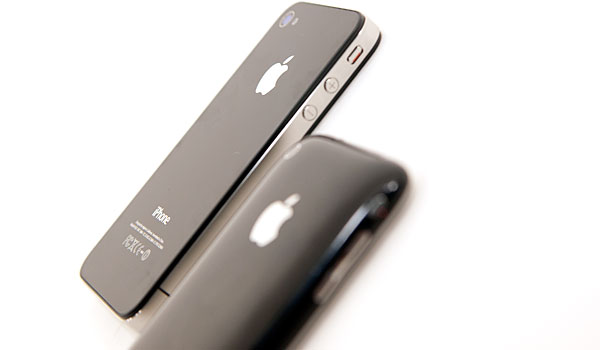
The straight lines, smaller dimensions and lack of unnecessary bulk make the 3GS feel like a car from the 90s, unnecessarily curvy. The styling is now so much more compact. Compared to the iPhone 3GS the 4 is around 5% narrower (but no more difficult to type on) and nearly 25% thinner. It even makes the Nexus One look dated:
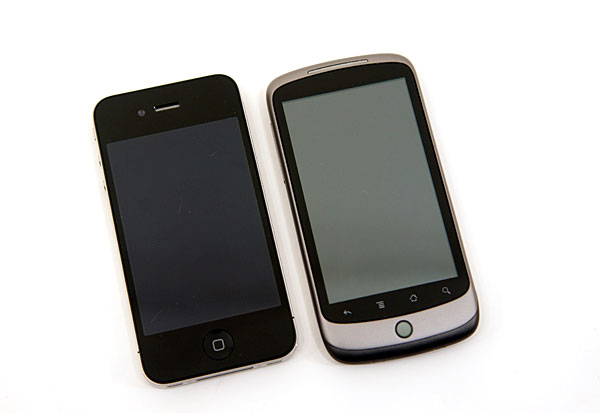
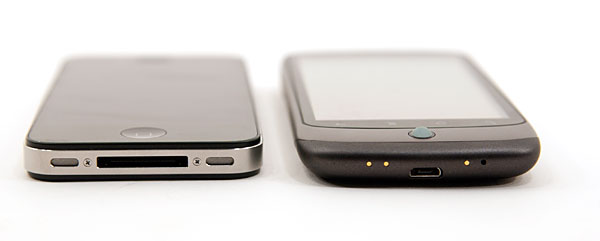
The iPhone 4 is slightly heavier than the 3GS (4.8oz vs. 4.7oz). You feel the added weight but I wouldn't call it heavy. The front and the back of the iPhone 4 are both made out of glass, and they protrude beyond the stainless steel band that wraps around the phone (more on this controversial decision later). While this gives the 4 an amazing finish, it also makes carrying the phone nerve racking. Coupled with the smaller, more dense form factor I’m now deathly afraid of dropping and shattering this thing. Apple has done a lot to reinforce the glass, however there have been enough reports already of shattered iPhone 4s for me not to feel very safe. Only Apple would think to make the two surfaces most likely to hit something out of glass. It's like making mouse traps out of cheese, something bad is bound to happen.

iPhone 4 (left) vs. iPhone 3GS (right)
The physical buttons (but not their layout) have changed on the 4. The ringer switch has shorter travel and feels sturdier as a result. The volume rocker has been replaced by discrete volume up/down buttons, also very sturdy in feel. The power/lock button is also now made out of stainless steel. Only the home button remains unchanged, although it does seem to make a deeper click when you use it.

The speaker moved to behind the right grill at the bottom of the phone instead of the left. The dock connector thankfully remained unchanged. It looks like Apple is committed to maintaining this connector until it makes the jump to something wireless (or optical?).

The back of the phone is pretty. Apple broke with tradition and finally included a single LED flash on the phone. The flash comes on in low light conditions and is enough to take shots in total darkness.
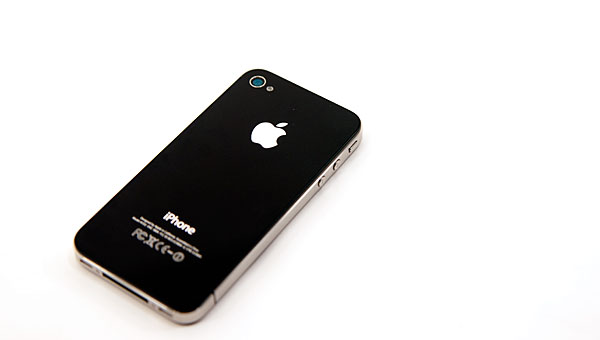
The camera has been upgraded to a low noise 5MP sensor. It can shoot stills at up to 2592 x 1936 or video at 1280 x 720 @ 30 fps. We’ll go into greater detail on its quality in the camera section. The iPhone 4 also adds a front facing camera capable of shooting both photos and video at 640 x 480.
Apple quotes contrast ratio as 1000:1, in our measurements we got very close (952:1). A significant improvement over the 188:1 ratio of the 3GS. Apple achieved this by both dropping black levels and increasing the white levels on the display. Improving both is always fine by me.
Internally the iPhone 4 uses Apple's new A4 SoC, built around an ARM Cortex A8 CPU and a PowerVR SGX GPU. The new SoC is built on a 45nm process and features 512MB of memory on the package. Apple hasn't made CPU clock speed public, but I'm guessing around 800MHz compared to the iPad's 1GHz for reasons you'll see later. GPU clock speed is unknown as well. Having more memory on package is an interesting move by Apple as it makes the iPhone 4 better suited for multitasking compared to the iPad. Also implying that shortly after the iPad gets multitasking it'll be updated to a version with more memory as well.
The iPhone now has an gyroscope as well the rotation sensors of its predecessors. Developers are given full access to the gyroscope making the iPhone 4 capable of becoming a very expensive Wii-mote.
| Physical Comparison | ||||||||
| Apple iPhone 4 | Apple iPhone 3GS | HTC EVO 4G (Qualcomm Snapdragon QSD8650) | HTC Droid Incredible (Qualcomm Snapdragon QSD8650) | Google Nexus One (Qualcomm Snapdragon QSD8250) | ||||
| Height | 115.2 mm (4.5") | 115 mm (4.5") | 121.9 mm (4.8") | 117.5 mm (4.63") | 119 mm (4.7") | |||
| Width | 58.6 mm (2.31") | 62.1 mm (2.44") | 66.0 mm (2.6") | 58.5 mm (2.30") | 59.8 mm (2.35") | |||
| Depth | 9.3 mm ( 0.37") | 12.3 mm (0.48") | 12.7 mm (0.5") | 11.9 mm (0.47") | 11.5 mm (0.45") | |||
| Weight | 137 g (4.8 oz) | 133 g (4.7 oz) | 170 g (6.0 oz) | 130 g (4.6 oz) | 130 g (4.6 oz) | |||
| CPU | Apple A4 @ ~800MHz | Apple/Samsung A3 @ 600MHz | Qualcomm Scorpion @ 1GHz | Qualcomm Scorpion @ 1GHz | Qualcomm Scorpion @ 1GHz | |||
| GPU | PowerVR SGX 535 | PowerVR SGX 535 | Adreno 200 | Adreno 200 | Adreno 200 | |||
| RAM | 512MB LPDDR1 (?) | 256MB LPDDR1 | 512MB LPDDR1 | 512MB LPDDR1 | 512MB LPDDR1 | |||
| NAND | 16GB or 32GB integrated | 16 or 32GB integrated | 8GB micro SD | 8GB micro SD | micro SD | |||
| Camera | 5MP with LED Flash + Front Facing Camera | 3MP | 8MP with dual LED Flash + Front Facing Camera | 8MP with LED Flash | 5MP with LED Flash | |||
| Screen | 3.5" 640 x 960 LED backlit LCD | 3.5" 320 x 480 | 4.3" 480 x 800 | 3.7" 480 x 800 AMOLED | 3.7" 480 x 800 AMOLED | |||
| Battery | Integrated 5.254Whr | Integrated 4.51Whr | Removable 5.5Whr | Removable 4.81 Whr | Removable 5.18 Whr | |||
The iPhone 4's logic board shrinks in size thanks to further component integration, making room for a much larger battery. The 5.25Whr battery in the iPhone 4 is a 16% increase from what was in the 3GS, and 95% of what HTC put in the EVO 4G. While raw performance improved, it's clear that Apple's focus this time around was battery life. Again, we'll dive into specifics later in the review.
Moving back outside Apple surrounded the phone with a stainless steel band. This band doubles as the 3G, WiFi and Bluetooth antennas. And if you hadn't noticed, it also moonlights as a giant elephant. Let's talk about it.










270 Comments
View All Comments
Belard - Friday, July 2, 2010 - link
On the back of all iPhones... whats with the ugly logos on the back of the phones?I don't know another phone that has such things and you'd think on a style-brand such as Apple, they really would work to NOT put such things on.
Look at the HTC-EVO review. Other than HTC & Sprint logos, its all nice and clean looking.
My SONY phones... only say Sony. Even the bottom of my Logitech mouse only has a CE logo and product text "DUAL LASER".
mikelward - Friday, July 2, 2010 - link
The Nexus One photos looked much better to me. The iPhone 4 was too yellow and the Evo was too noisy.Out of interest, is this something that could be fixed in a firmware update, and what version of Android was the N1 running?
Thank you very much for the review, especially the antenna section.
QuantumForce - Friday, July 2, 2010 - link
Did you average dBs as if they were linear numbers? Really? They are a log transform of a ratio between measured and standard linear intensity or pressure. 20 dB * 2 is not equal to 40 dB. Just how did you deal with the math here in your sample analysis of six readings?
metalev - Friday, July 2, 2010 - link
I re-charted the signal strength quoted in this article to make the huge signal strength range given to 5 bars much more obvious:http://www.metalev.org/2010/07/apple-caught-red-ha...
KOTULCN - Saturday, July 3, 2010 - link
You said you restored your iPhone 4 to a back-up of a jail broken 3.1.3? Alittle bit more explanation is due!MrBrownSound - Saturday, July 3, 2010 - link
Very detailed review. In the end with Froyo coming I'd have to choose Evo no matter the extended wait because of integration with sense UI. Although I will have to compromise battery life, stunning display and sheer expensive look and feel compared to the iphone. To make up for it I will be able to make calls, have a bigger screen, and also have the all open android OS. trade-offs trade-offs. I'll take it over being locked to at&t for two years with three hundred something termination fee.Again very thorough review. This is why i read Anandtech
spiritu - Saturday, July 3, 2010 - link
I note that some subtle but significant changes have been made to your article since it was first published.In particular, the following line:
It originally said:
"Apple should add an insulative coating to the stainless steel band (which implies a recall), or subsidize bumper cases." (which implies apple should pay for the cost of the bumper)
Now it says:
"The most sensitive region of the antenna should have an insulative coating (next time round?), or everyone should use a case. (which implies the user should buy a bumper).
I can only presume that you made these changes under duress.
orangpelupa - Saturday, July 3, 2010 - link
great review. very in-depth. Nice knowing what the reason behind iPhone 4 "signal problem".btw
seeing this
http://images.anandtech.com/doci/3794/iPhone4-3422...
i got struck by nostalgic feeling :D
it really looks like my 4 years old cellphone. (now its dead lol)
Sony Ericsson M600i.
http://img23.imageshack.us/img23/9964/030720101018...
the "sides" design really remind me of my old phone :)
drwho9437 - Saturday, July 3, 2010 - link
"The Antenna is Improved" is a subheading. The content is more or less fine, but it shouldn't be called the Antenna is improved. If the software is correctly reporting the number of dBm and it just works at lower levels because of a lower noise floor in the RF amplifier, then you should say "reception is Improved" or something.The improvement in the signal is down to the mixer, amp or filters not the antenna gain as you note from your dBm level measures.
Axelband - Saturday, July 3, 2010 - link
This is simply the best and most thorough product review I have ever read. It had just enough technical information to satisfy an engineer like me but not too much to bore a layman. Bookmarking your site now.